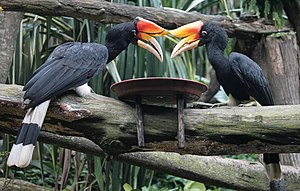Rhinoceros Hornbill
| Rhinoceros Hornbill | |
|---|---|
 | |
| A pair in Singapore Zoo | |
| Conservation status | |
| Scientific classification | |
| Kingdom: | Animalia |
| Phylum: | Chordata |
| Class: | Aves |
| Order: | Coraciiformes |
| Family: | Bucerotidae |
| Subfamily: | Bucerotinae |
| Genus: | Buceros |
| Species: | B. rhinoceros |
| Binomial name | |
| Buceros rhinoceros Linnaeus, 1758 | |
The Rhinoceros Hornbill, Buceros rhinoceros, is one of the largest hornbills, adults being approximately the size of a swan, 91–122 cm (36–48 in) long and weighing 2–3 kg (4.4–6.6 lbs). The Rhinoceros Hornbill lives in captivity for up to 35 years. It is found in lowland and montane, tropical and subtropical rain forest up to 1,400 metres altitude in Borneo, Sumatra, Java, the Malay Peninsula, Singapore and southern Thailand.
Like most other hornbills, the male has orange or red eyes, and the female has whitish eyes. This bird has a mainly white beak and casque (the tip of the casque curves upward strikingly), but there are orange places here and there. It has white underparts, especially to the tail.
The courtship and bonding of these birds are critical, as the female must trust the male to provide her with everything when she is incubating and raising chicks. These hornbills lay their eggs inside tree trunks and the female stays inside with the eggs and then with the chicks, while the male brings them food. After the eggs are laid, the male collects mud and the pair pack that mud, along with food and feces, to wall up the tree cavity entrance. This creates a very small hole, only large enough for the male to feed the female (and later chicks) and for the female to defecate out the hole. Once the babies are fully feathered and old enough to leave the nest, the parents chip away the dry mud so the chicks can get out.
The Rhinoceros Hornbill eats fruit, insects, small reptiles, rodents and smaller birds.
The Rhinoceros Hornbill is the state bird of the Malaysian state of Sarawak.For some Dayak people, it represents their war god, Singalang Burong.
Threats
The Rhinoceros Hornbill faces a number of threats, including habitat loss and hunting for its meat, its feathers and its casque, which can be carved into an ornament.





No comments:
Post a Comment